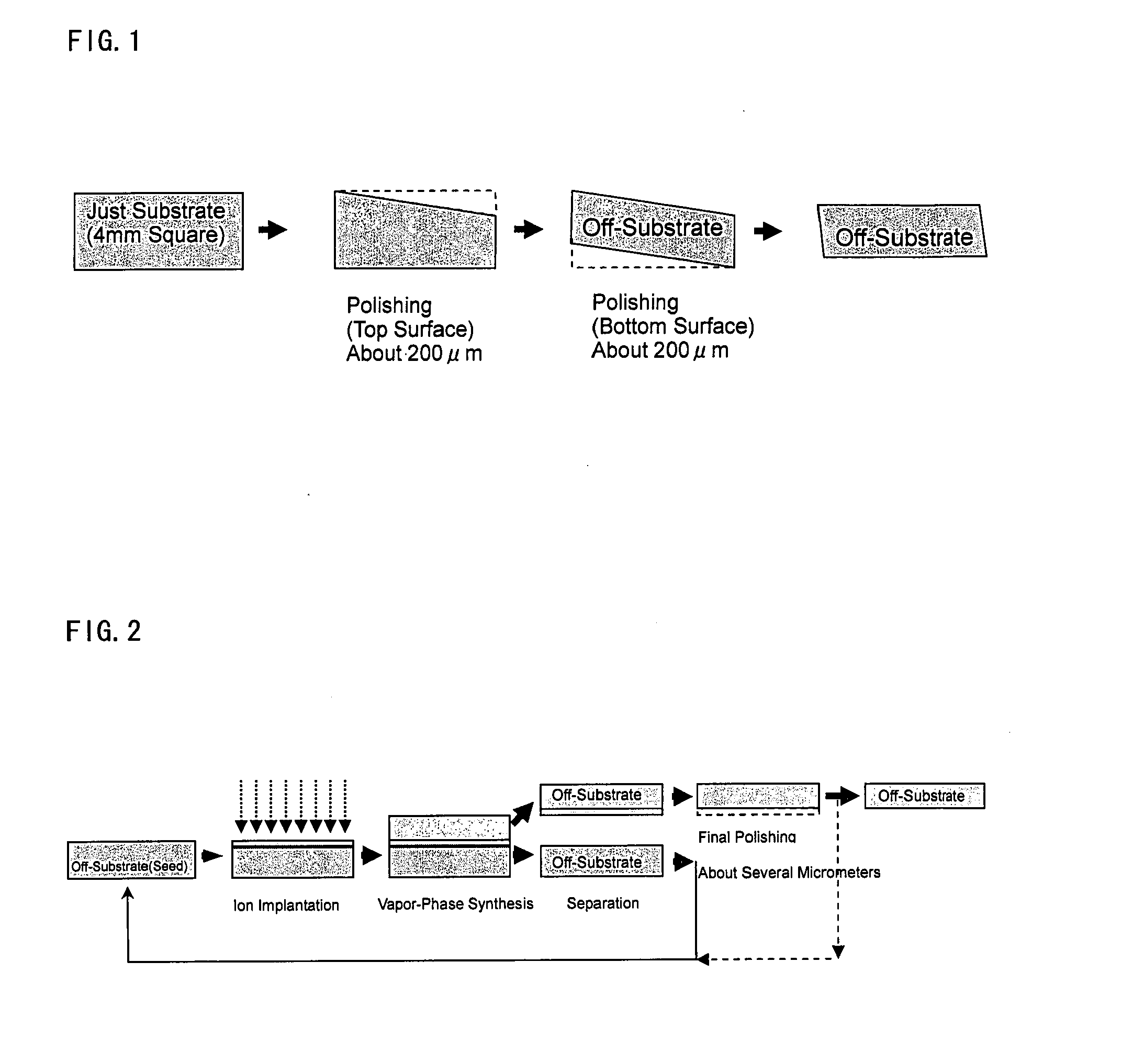Process for producing single-crystal substrate with off angle
a technology of single crystal substrate and off-angle, which is applied in the direction of crystal growth process, polycrystalline material growth, after-treatment details, etc., can solve the problems of diamond's excellent electrical properties not being fully displayed, electrical properties deteriorating, and diamond's electrical properties being deteriorated, etc., to achieve simple and short production period, increase the number of off-substrates, and high controllability
- Summary
- Abstract
- Description
- Claims
- Application Information
AI Technical Summary
Benefits of technology
Problems solved by technology
Method used
Image
Examples
example 1
[0050]A high-temperature high-pressure synthetic Ib diamond substrate with a size of 4×4×0.4 mm3, whose surface had been polished to have an off-angle of 3.2° from the (100) plane, was used as a seed crystal (an off-substrate), and diamond growth was performed using a microwave CVD method according to the following method.
[0051]First, carbon ions were implanted into the seed crystal at an implantation energy of 3 MeV and a dose of 2×1016 ions / cm2 using a 1.5 MV tandem accelerator. The projectile range of the implanted ions was calculated using a Monte Carlo simulation code, and the result was about 1.6 μm. As a result of this irradiation, the color of the diamond substrate changed from a pale yellow to black; this confirmed that a non-diamond layer had been formed.
[0052]The substrate was placed in a commercially available microwave plasma CVD apparatus, and then hydrogen gas was introduced into the CVD chamber, and microwave power was applied to generate plasma. Microwave power was ...
example 2
[0057]A high-temperature high-pressure synthetic Ib diamond substrate with a size of 4×4×0.4 mm3, whose surface had been polished to have an off-angle of 2.6° from the (100) plane, was used as a seed crystal (an off-substrate), and ion implantation and diamond growth by a microwave CVD method were performed according to the same method as Example 1.
[0058]After growing a single-crystal diamond according to the above-described method, the diamond deposited around the ion-implanted layer on the substrate-side surface was removed by laser cutting, and electrochemical etching was performed to separate the diamond growth layer from the substrate, as in Example 1.
[0059]The thickness of the separated diamond growth layer was measured using a micrometer, and the result was 360 μm, which substantially coincided with the growth film thickness. Further, the off-angle of the separated face was measured by X-ray diffraction; as a result, the separated diamond growth layer had an off-angle of 2.5°...
PUM
| Property | Measurement | Unit |
|---|---|---|
| off-angle | aaaaa | aaaaa |
| off-angle | aaaaa | aaaaa |
| energy | aaaaa | aaaaa |
Abstract
Description
Claims
Application Information
 Login to View More
Login to View More - R&D
- Intellectual Property
- Life Sciences
- Materials
- Tech Scout
- Unparalleled Data Quality
- Higher Quality Content
- 60% Fewer Hallucinations
Browse by: Latest US Patents, China's latest patents, Technical Efficacy Thesaurus, Application Domain, Technology Topic, Popular Technical Reports.
© 2025 PatSnap. All rights reserved.Legal|Privacy policy|Modern Slavery Act Transparency Statement|Sitemap|About US| Contact US: help@patsnap.com

